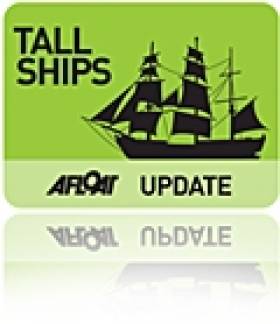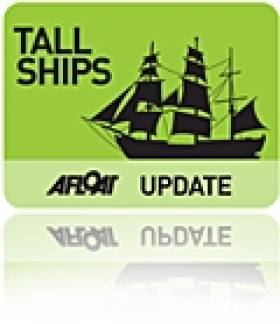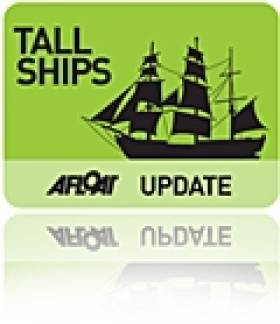Displaying items by tag: HMS Bounty
HMS Bounty: The Tall Ship That Should Never Have Sailed?
#TallShips - What was the HMS Bounty doing in the middle of Hurricane Sandy? It's a question that Kathryn Miles - author of a book on the history of the Jeanie Johnston - attempts to answer for Outside magazine.
As reported last October on Afloat.ie, the tall ship replica of the 18th-century square-rigged vessel - and a previous visitor to Irish shores - was sunk in the Atlantic some 100 miles off Cape Fear, forcing its crew into liferafts.
The ship's captain Robin Walbridge went missing in the incident and is presumed dead.
According to Outside, the ship has has a tumultuous history since its construction for the 1960 Hollywood film Mutiny On The Bounty starring Marlon Brando - weathering life as a seaside attraction at a Florida resort town, and as an extra in two of the Pirates of the Caribbean movies.
Since 1995 it was skippered by Walbridge, who "worked tirelessly to preserve the vessel" and took her as far and wide as the Great Lakes, the Panama Canal and Europe - including visits to Cork Harbour in 2009 and Belfast Lough in 2011, reflecting the original vessel's Irish connections (Captain William Bligh designed the North Bull Wall and surveyed Dublin Bay some years after the infamous mutiny).
But preservation requires funding, and it's that struggle for funding that may have encouraged the captain to push the limits of his vessel and its crew.
Outside has much more on the story HERE.
Speculation over Loss of HMS Bounty 'Not Helpful' – Tall Ships America
#Tallships – The education under sail organisation in the United States, 'Tall Ships America' has expressed its hope for the speed recovery of HMS Bounty Captain following the foundering of HMS BOUNTY during Hurricance Sandy this week. The organisation has also said the current speculation into the sinking of the vessel is not helpful at this time.
Tall Ships America have issued the following statement: The tall ship HMS BOUNTY was lost yesterday in Hurricane Sandy off Cape Hatteras, North Carolina. Of the 16 persons reportedly aboard at the time, we understand that one individual has perished, and that 14 others were rescued, thanks to the exemplary courage and skill of Coast Guard search and rescue personnel. It appears that the vessel's master, Robin Walbridge, is missing, and the search continues.
A member of Tall Ships America, HMS BOUNTY was a popular participant in public maritime festivals around North America. Our membership is united in sending our thoughts, prayers and best wishes to the crew and their families, to the family of the crewmember who was lost, and to the brave Coast Guard team who sustain our hopes for Captain Walbridge's speedy rescue.
There is currently much speculation about the loss of the vessel. We believe that further speculation is not helpful at this time, especially in view of the respect that is due to the individuals whose lives are directly affected by these tragic events. Tall Ships America does not have any factual information to add but notes that there will surely be an official inquiry that will assemble much more complete information than is available to anyone now. We are confident that our membership, if called upon, will cooperate with that inquiry in the full spirit of professionalism upon which the sail training movement depends.
For now, we appeal to the public to lend their thoughts and support to the crew and shore team of HMS BOUNTY and their families, to join us in thanking the Coast Guard rescue team for their heroism on behalf of our colleagues, and to sustain hopes for Captain Walbridge's safe return.
Tall Ships America is a non-profit organization dedicated to enriching youth education through character building and leadership programs aboard tall ships. It is the hub for tall ship activity, expertise, and information in North America, and is commended by Congress as the Sail Training organization representing the United States.
#tallship – A Tall Ship replica 18th-century sailing vessel, a visitor to Irish ports in 2009, was caught in Hurricane Sandy's and sunk leaving the captain missing and forcing the crew into liferafts in rough seas off the North American coast.
The U.S. Coast Guard rescued 14 people by helicopter and spent much of the day searching for two missing crew members.
One of them, 42-year-old Claudene Christian, was found unresponsive in the water on Monday evening. She was taken to hospital while rescuers continued to search for the missing captain of the HMS Bounty, 63-year-old Robin Walbridge.
Both Christian and Wallbridge were wearing survival suits designed to help keep them afloat and protected from cold waters for up to 15 hours.
The famed H.M.S. Bounty, led by Captain Robin Walbridge and a crew of 18, arrived in Cobh at the Port of Cork in the summer of 2009. In June last year the 200-tonne ship arrived into Belfast Lough for the Belfast Titanic Maritime Festival.
The HMS Bounty was built at Smith and Ruhland Shipyard in Lunenburg, N.S. for the 1962 film "Mutiny on the Bounty" - had left Connecticut last week en route to Florida.
Coast Guard Vice Adm. Robert Parker, Operational Commander for the Atlantic Area, told ABC's "Good Morning America" that the ship had taken on about three metres of water when the crew abandoned it.
Amid high winds and 5.5-metre seas, two helicopters flew in for the rescue around dawn Monday, plucking crew members from the lifeboats.
A Weekend to Explore the 'Bounty'
The Cork-berthed replica HMS Bounty, the purpose built movie prop tallship used in the 1962 MGM studies film release of 'Mutiny and the Bounty' starring Marlon Brando, will be open to visitors from tomorrow, writes Jehan Ashmore.
The famous tall ship is to open to the public between (11am-6pm) and these times also apply to the Saturday and Sunday. Tours on board the Bounty are self-guided with crew assistance. Admission charges are €10 for adults and children €5, children under four years go free.
The Bounty is berthed at Albert Quay which faces opposite the Cork City Marina on the south quays of the city-centre.
The public can explore her "tween" deck 8' foot ceilings, this made it easier for the film crew and their equipment to access.
As a result, Bounty has been hired by filmcrews for the making of 'Treasure Island', 'Yellowbeard', 'Sponge Bob, Square Pants, the Movie' and 'Pirates of the Caribbean - Dead Man's Chest'. In addition to commercial movies, Bounty has also been the stage for many documentaries.
To compare the differences between the replica and the original 18th century built 'Bounty' click HERE.
Brando’s ‘Bounty’ Bound for Bloomsday
The tallship used in the 1962 film of 'Mutiny and the Bounty' starring Hollywood screen legend Marlon Brando is to make a Bloomsday arrival to the rebel city, writes Jehan Ashmore.
H.M.S. Bounty is a replica of the ship in the famous 1789 mutiny against Captain William Bligh. The tallship is to dock at Albert Quay in Cork city-centre and will be made open to the public on Friday 17th, Saturday 18th and Sunday 19th June (daily between 11am – 6pm).
Tours on board the Bounty are self-guided with crew assistance and the admission charge is €10 for adults and children €5, children under four years go free.
In recent years the Bounty has appeared in 'Pirates of the Caribbean II' and in the Lone Wolf Production Group documentary on 'Blackbeard'. The ship also appeared in 2003 for a documentary on Captain Bligh for the History Channel, and the Sponge Bob Square Pants movie, which was released in November 2004. Also in that year the tallship was used in an episode for MTV.
For more information about the Cork visit click HERE and for the Bounty's voyages and background, visit www.tallshipbounty.org
































































